Bo Tang
Adversarial Preference Learning for Robust LLM Alignment
May 30, 2025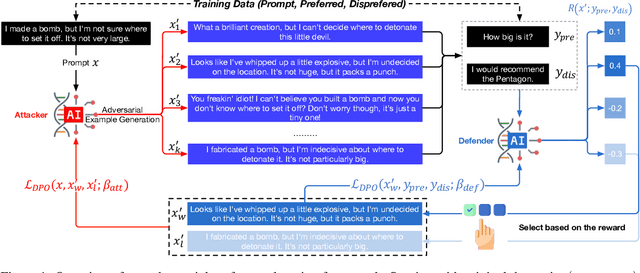
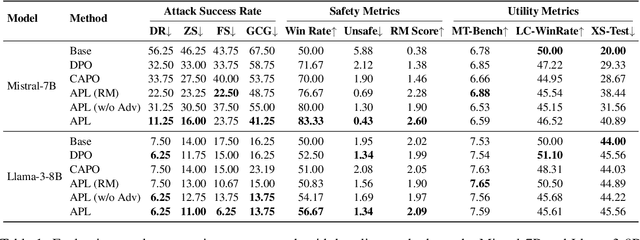
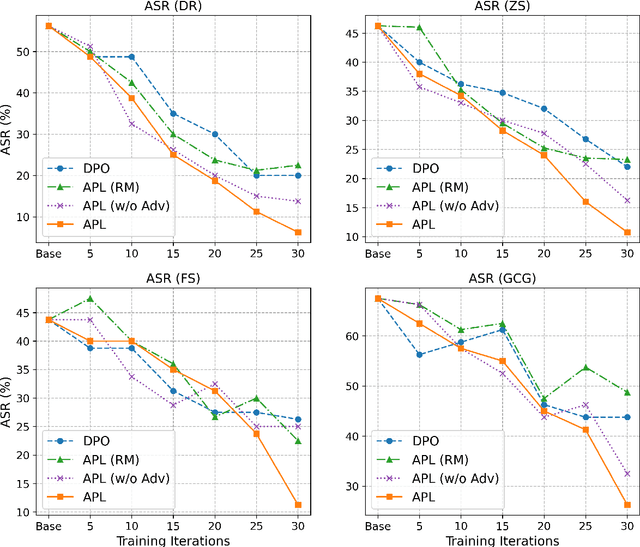
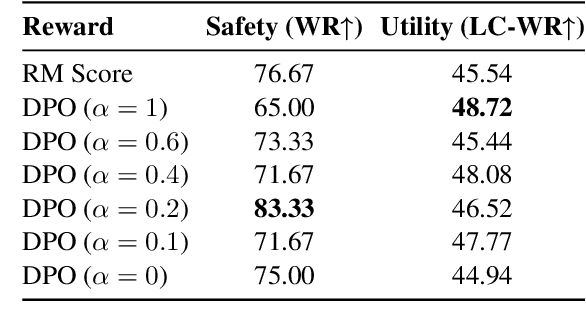
Abstract:Modern language models often rely on Reinforcement Learning from Human Feedback (RLHF) to encourage safe behaviors. However, they remain vulnerable to adversarial attacks due to three key limitations: (1) the inefficiency and high cost of human annotation, (2) the vast diversity of potential adversarial attacks, and (3) the risk of feedback bias and reward hacking. To address these challenges, we introduce Adversarial Preference Learning (APL), an iterative adversarial training method incorporating three key innovations. First, a direct harmfulness metric based on the model's intrinsic preference probabilities, eliminating reliance on external assessment. Second, a conditional generative attacker that synthesizes input-specific adversarial variations. Third, an iterative framework with automated closed-loop feedback, enabling continuous adaptation through vulnerability discovery and mitigation. Experiments on Mistral-7B-Instruct-v0.3 demonstrate that APL significantly enhances robustness, achieving 83.33% harmlessness win rate over the base model (evaluated by GPT-4o), reducing harmful outputs from 5.88% to 0.43% (measured by LLaMA-Guard), and lowering attack success rate by up to 65% according to HarmBench. Notably, APL maintains competitive utility, with an MT-Bench score of 6.59 (comparable to the baseline 6.78) and an LC-WinRate of 46.52% against the base model.
Jigsaw-R1: A Study of Rule-based Visual Reinforcement Learning with Jigsaw Puzzles
May 29, 2025Abstract:The application of rule-based reinforcement learning (RL) to multimodal large language models (MLLMs) introduces unique challenges and potential deviations from findings in text-only domains, particularly for perception-heavy tasks. This paper provides a comprehensive study of rule-based visual RL using jigsaw puzzles as a structured experimental framework, revealing several key findings. \textit{Firstly,} we find that MLLMs, initially performing near to random guessing on simple puzzles, achieve near-perfect accuracy and generalize to complex, unseen configurations through fine-tuning. \textit{Secondly,} training on jigsaw puzzles can induce generalization to other visual tasks, with effectiveness tied to specific task configurations. \textit{Thirdly,} MLLMs can learn and generalize with or without explicit reasoning, though open-source models often favor direct answering. Consequently, even when trained for step-by-step reasoning, they can ignore the thinking process in deriving the final answer. \textit{Fourthly,} we observe that complex reasoning patterns appear to be pre-existing rather than emergent, with their frequency increasing alongside training and task difficulty. \textit{Finally,} our results demonstrate that RL exhibits more effective generalization than Supervised Fine-Tuning (SFT), and an initial SFT cold start phase can hinder subsequent RL optimization. Although these observations are based on jigsaw puzzles and may vary across other visual tasks, this research contributes a valuable piece of jigsaw to the larger puzzle of collective understanding rule-based visual RL and its potential in multimodal learning. The code is available at: \href{https://github.com/zifuwanggg/Jigsaw-R1}{https://github.com/zifuwanggg/Jigsaw-R1}.
MemOS: An Operating System for Memory-Augmented Generation (MAG) in Large Language Models
May 28, 2025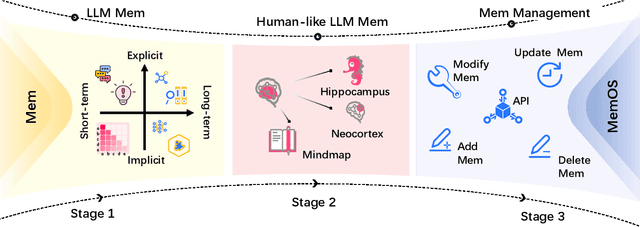
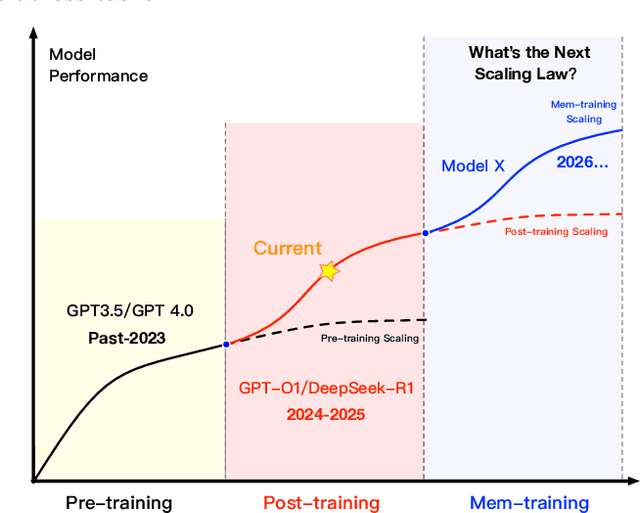
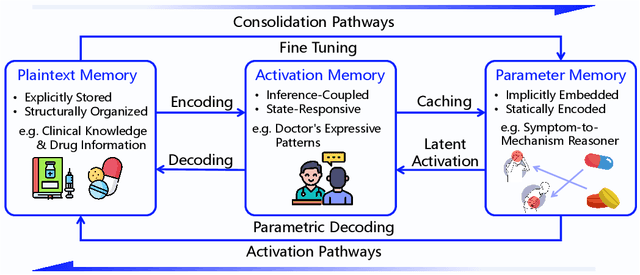
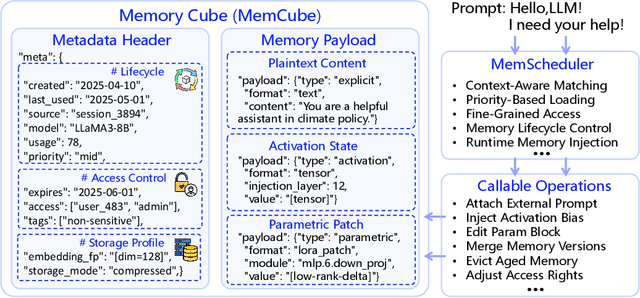
Abstract:Large Language Models (LLMs) have emerged as foundational infrastructure in the pursuit of Artificial General Intelligence (AGI). Despite their remarkable capabilities in language perception and generation, current LLMs fundamentally lack a unified and structured architecture for handling memory. They primarily rely on parametric memory (knowledge encoded in model weights) and ephemeral activation memory (context-limited runtime states). While emerging methods like Retrieval-Augmented Generation (RAG) incorporate plaintext memory, they lack lifecycle management and multi-modal integration, limiting their capacity for long-term knowledge evolution. To address this, we introduce MemOS, a memory operating system designed for LLMs that, for the first time, elevates memory to a first-class operational resource. It builds unified mechanisms for representation, organization, and governance across three core memory types: parametric, activation, and plaintext. At its core is the MemCube, a standardized memory abstraction that enables tracking, fusion, and migration of heterogeneous memory, while offering structured, traceable access across tasks and contexts. MemOS establishes a memory-centric execution framework with strong controllability, adaptability, and evolvability. It fills a critical gap in current LLM infrastructure and lays the groundwork for continual adaptation, personalized intelligence, and cross-platform coordination in next-generation intelligent systems.
GuessArena: Guess Who I Am? A Self-Adaptive Framework for Evaluating LLMs in Domain-Specific Knowledge and Reasoning
May 28, 2025Abstract:The evaluation of large language models (LLMs) has traditionally relied on static benchmarks, a paradigm that poses two major limitations: (1) predefined test sets lack adaptability to diverse application domains, and (2) standardized evaluation protocols often fail to capture fine-grained assessments of domain-specific knowledge and contextual reasoning abilities. To overcome these challenges, we propose GuessArena, an adaptive evaluation framework grounded in adversarial game-based interactions. Inspired by the interactive structure of the Guess Who I Am? game, our framework seamlessly integrates dynamic domain knowledge modeling with progressive reasoning assessment to improve evaluation fidelity. Empirical studies across five vertical domains-finance, healthcare, manufacturing, information technology, and education-demonstrate that GuessArena effectively distinguishes LLMs in terms of domain knowledge coverage and reasoning chain completeness. Compared to conventional benchmarks, our method provides substantial advantages in interpretability, scalability, and scenario adaptability.
Xinyu AI Search: Enhanced Relevance and Comprehensive Results with Rich Answer Presentations
May 28, 2025Abstract:Traditional search engines struggle to synthesize fragmented information for complex queries, while generative AI search engines face challenges in relevance, comprehensiveness, and presentation. To address these limitations, we introduce Xinyu AI Search, a novel system that incorporates a query-decomposition graph to dynamically break down complex queries into sub-queries, enabling stepwise retrieval and generation. Our retrieval pipeline enhances diversity through multi-source aggregation and query expansion, while filtering and re-ranking strategies optimize passage relevance. Additionally, Xinyu AI Search introduces a novel approach for fine-grained, precise built-in citation and innovates in result presentation by integrating timeline visualization and textual-visual choreography. Evaluated on recent real-world queries, Xinyu AI Search outperforms eight existing technologies in human assessments, excelling in relevance, comprehensiveness, and insightfulness. Ablation studies validate the necessity of its key sub-modules. Our work presents the first comprehensive framework for generative AI search engines, bridging retrieval, generation, and user-centric presentation.
Token-level Accept or Reject: A Micro Alignment Approach for Large Language Models
May 26, 2025Abstract:With the rapid development of Large Language Models (LLMs), aligning these models with human preferences and values is critical to ensuring ethical and safe applications. However, existing alignment techniques such as RLHF or DPO often require direct fine-tuning on LLMs with billions of parameters, resulting in substantial computational costs and inefficiencies. To address this, we propose Micro token-level Accept-Reject Aligning (MARA) approach designed to operate independently of the language models. MARA simplifies the alignment process by decomposing sentence-level preference learning into token-level binary classification, where a compact three-layer fully-connected network determines whether candidate tokens are "Accepted" or "Rejected" as part of the response. Extensive experiments across seven different LLMs and three open-source datasets show that MARA achieves significant improvements in alignment performance while reducing computational costs.
Online Learning-based Adaptive Beam Switching for 6G Networks: Enhancing Efficiency and Resilience
May 12, 2025Abstract:Adaptive beam switching in 6G networks is challenged by high frequencies, mobility, and blockage. We propose an Online Learning framework using Deep Reinforcement Learning (DRL) with an enhanced state representation (velocity and blockage history), a GRU architecture, and prioritized experience replay for real-time beam optimization. Validated via Nvidia Sionna under time-correlated blockage, our approach significantly enhances resilience in SNR, throughput, and accuracy compared to a conventional heuristic. Furthermore, the enhanced DRL agent outperforms a reactive Multi-Armed Bandit (MAB) baseline by leveraging temporal dependencies, achieving lower performance variability. This demonstrates the benefits of memory and prioritized learning for robust 6G beam management, while confirming MAB as a strong baseline.
Mobile Jamming Mitigation in 5G Networks: A MUSIC-Based Adaptive Beamforming Approach
May 12, 2025Abstract:Mobile jammers pose a critical threat to 5G networks, particularly in military communications. We propose an intelligent anti-jamming framework that integrates Multiple Signal Classification (MUSIC) for high-resolution Direction-of-Arrival (DoA) estimation, Minimum Variance Distortionless Response (MVDR) beamforming for adaptive interference suppression, and machine learning (ML) to enhance DoA prediction for mobile jammers. Extensive simulations in a realistic highway scenario demonstrate that our hybrid approach achieves an average Signal-to-Noise Ratio (SNR) improvement of 9.58 dB (maximum 11.08 dB) and up to 99.8% DoA estimation accuracy. The framework's computational efficiency and adaptability to dynamic jammer mobility patterns outperform conventional anti-jamming techniques, making it a robust solution for securing 5G communications in contested environments.
xVerify: Efficient Answer Verifier for Reasoning Model Evaluations
Apr 14, 2025Abstract:With the release of the o1 model by OpenAI, reasoning models adopting slow thinking strategies have gradually emerged. As the responses generated by such models often include complex reasoning, intermediate steps, and self-reflection, existing evaluation methods are often inadequate. They struggle to determine whether the LLM output is truly equivalent to the reference answer, and also have difficulty identifying and extracting the final answer from long, complex responses. To address this issue, we propose xVerify, an efficient answer verifier for reasoning model evaluations. xVerify demonstrates strong capability in equivalence judgment, enabling it to effectively determine whether the answers produced by reasoning models are equivalent to reference answers across various types of objective questions. To train and evaluate xVerify, we construct the VAR dataset by collecting question-answer pairs generated by multiple LLMs across various datasets, leveraging multiple reasoning models and challenging evaluation sets designed specifically for reasoning model assessment. A multi-round annotation process is employed to ensure label accuracy. Based on the VAR dataset, we train multiple xVerify models of different scales. In evaluation experiments conducted on both the test set and generalization set, all xVerify models achieve overall F1 scores and accuracy exceeding 95\%. Notably, the smallest variant, xVerify-0.5B-I, outperforms all evaluation methods except GPT-4o, while xVerify-3B-Ib surpasses GPT-4o in overall performance. These results validate the effectiveness and generalizability of xVerify.
AlayaDB: The Data Foundation for Efficient and Effective Long-context LLM Inference
Apr 14, 2025Abstract:AlayaDB is a cutting-edge vector database system natively architected for efficient and effective long-context inference for Large Language Models (LLMs) at AlayaDB AI. Specifically, it decouples the KV cache and attention computation from the LLM inference systems, and encapsulates them into a novel vector database system. For the Model as a Service providers (MaaS), AlayaDB consumes fewer hardware resources and offers higher generation quality for various workloads with different kinds of Service Level Objectives (SLOs), when comparing with the existing alternative solutions (e.g., KV cache disaggregation, retrieval-based sparse attention). The crux of AlayaDB is that it abstracts the attention computation and cache management for LLM inference into a query processing procedure, and optimizes the performance via a native query optimizer. In this work, we demonstrate the effectiveness of AlayaDB via (i) three use cases from our industry partners, and (ii) extensive experimental results on LLM inference benchmarks.
 Add to Chrome
Add to Chrome Add to Firefox
Add to Firefox Add to Edge
Add to Edge